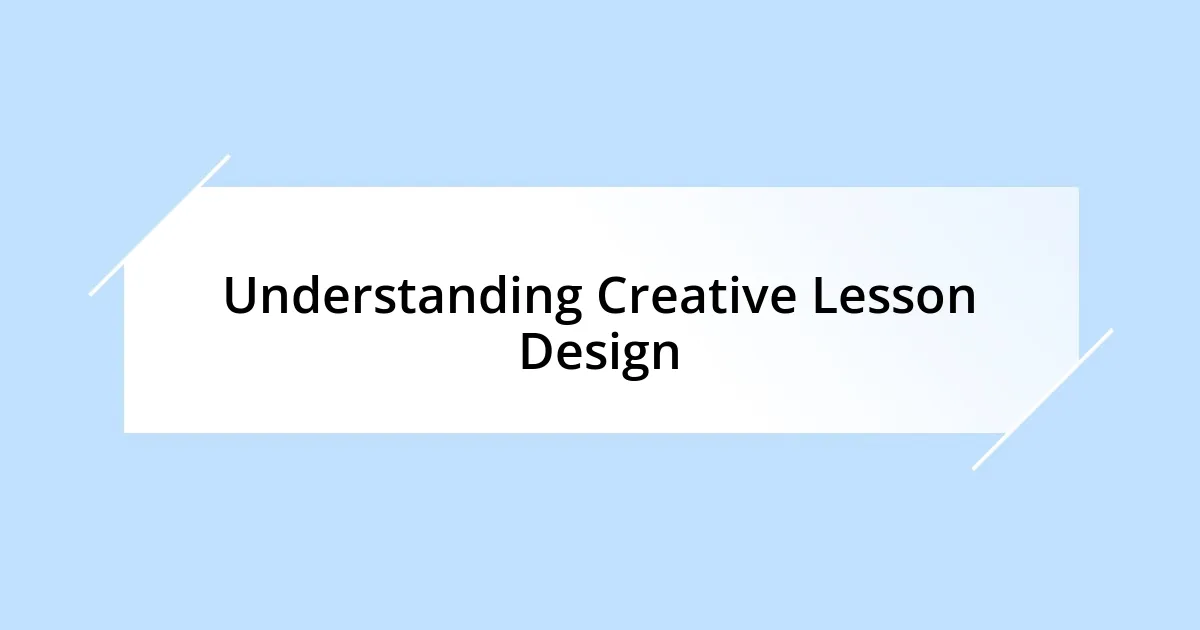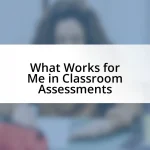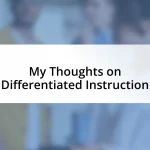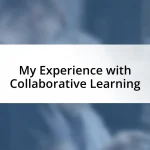Key takeaways:
- Creative lesson design emphasizes understanding students’ interests and backgrounds to enhance engagement and learning outcomes.
- Integrating technology and gamification fosters excitement and active participation in lessons, transforming learning into an interactive experience.
- Regular reflection on lesson outcomes and student feedback helps educators adjust their strategies to better meet diverse learning needs.
- Creating a supportive environment encourages all students to participate, ensuring that even quieter voices are heard and valued.

Understanding Creative Lesson Design
Creative lesson design goes beyond traditional teaching methods; it’s about crafting experiences that resonate with learners. I remember when I introduced a project-based assignment that allowed my students to explore their passions through art. It was incredible to see their eyes light up when they realized they could express their ideas creatively. Isn’t it amazing how a little freedom can spark enthusiasm?
In my experience, understanding your learners is crucial to successful lesson design. I’ve often found that taking time to get to know my students—not just their academic skills but their interests, backgrounds, and challenges—makes all the difference. For instance, I once tailored a lesson around a popular local culture event, which transformed the energy in the classroom. Why is it that when we connect on a personal level, learning becomes so much richer?
Another key element of creative lesson design is flexibility. I’ve had lessons that completely shifted direction based on students’ responses and questions. I’ve learned to embrace those moments of spontaneity; it’s often where the most profound learning occurs. Have you ever noticed how a simple conversation can open up new pathways to understanding? That’s the beauty of creative lesson design—it’s a dance between structure and spontaneity.

Importance of Engaging Lessons
Engaging lessons are vital because they capture student attention and foster a vibrant learning environment. When I employed storytelling within a science lesson, I was amazed to see students hanging on every word. It was more than just facts; it became a shared journey, transforming passive listeners into active participants.
- Captures student interest and curiosity.
- Encourages active participation and discussion.
- Fosters a deeper understanding of the material.
- Builds a positive classroom atmosphere.
- Supports diverse learning styles and needs.
In my experience, engagement acts like a catalyst for motivation. One day, I introduced a collaborative challenge where students had to design their own eco-friendly inventions. The excitement in the room was palpable, and I could feel their passion spark as they brainstormed together. It reminded me that when lessons are engaging, they not only learn but also build connections that last beyond the classroom walls.

Techniques for Innovative Lesson Ideas
Techniques for innovative lesson ideas can truly transform the learning experience. One approach that I have found exceptionally effective is integrating technology in meaningful ways. For instance, I once created a virtual scavenger hunt using an app that allowed students to explore various historical sites. Watching their faces light up as they discovered information on their own was a moment I’ll always cherish. It’s fascinating how digital tools can bridge the gap between information and excitement, isn’t it?
Another technique that resonates with me is the use of gamification in lessons. When I implemented a classroom competition based on a popular video game, students dove headfirst into the material. They didn’t just study; they strategized, collaborated, and had fun while learning! Seeing my students so engaged made me realize that creativity can turn a mundane topic into a thrilling adventure. Have you ever witnessed the shift in energy when students become competitors rather than just learners?
Furthermore, nurturing a safe space for brainstorming can ignite innovative ideas. I set up “Think Tank” sessions where students could freely share their thoughts without judgment. In one such session, a quiet student proposed a unique project related to sustainability that eventually became the highlight of our semester. It reminded me that when students feel confident to express themselves, it nurtures not only creativity but also a sense of belonging within the classroom. The magic happens when they realize their voices matter.
| Technique | Benefits |
|---|---|
| Integrating Technology | Enhances engagement, makes learning interactive |
| Gamification | Motivates students, encourages teamwork and participation |
| Brainstorming Sessions | Fosters creativity, builds confidence and belonging |

Evaluating Student Engagement Strategies
Evaluating student engagement strategies is an essential step to understanding how well your lessons resonate with learners. I recall a moment when I decided to survey my students about what activities excited them the most. The feedback was illuminating; they had a thirst for hands-on projects over traditional lectures. This experience taught me that by actively seeking their input, I could tailor my strategies to align with their interests, nurturing an environment where they felt valued.
Another strategy I explored was observing my classroom dynamics during group activities. One day, while students tackled a physics problem using a hands-on approach, I noticed some groups thrived in collaboration while others struggled with communication. This disparity prompted me to reflect on my grouping methods and adjust accordingly, ensuring each team balanced various strengths. Have you ever considered how the way we group students can impact their engagement levels? In my case, fostering collaboration among diverse skill sets not only enriched discussions but also boosted the overall enthusiasm in the classroom.
Lastly, I believe in the power of self-reflection as a tool for evaluating engagement. After each lesson, I often took time to assess what worked and what didn’t by journaling my observations and student participation. One time, I thought a particular lecture would be a hit, but the lack of questions made me reconsider my approach. This simple act of reflection not only held me accountable but also sharpened my ability to design future lessons that truly resonate with my students. How often do we take a moment to reflect on our teaching methods and their efficacy? By doing so, we can continually evolve and engage our students in meaningful ways.

Adapting Lessons for Diverse Learners
Adapting lessons for diverse learners is a dynamic challenge that requires constant reflection and flexibility. I vividly remember a time when I had a class with students from various backgrounds, each bringing unique perspectives. To address this, I incorporated visual aids, written instructions, and oral explanations to cater to different learning styles. The moment I saw a student who typically struggled quickly grasp a concept through a diagram was incredibly rewarding. Isn’t it amazing how positive reinforcement can change a student’s entire outlook on learning?
One strategy I embrace is offering choices in assignments. During a unit on ecosystems, I gave my students the freedom to choose between creating a digital presentation, writing a report, or constructing a model. This choice empowered them and allowed creativity to flourish. When a shy student opted for the model and shared her project with pride, I felt a surge of joy. It’s those moments that remind me how giving students ownership not only engages them but fosters a deeper connection to the material. How often do we, as educators, underestimate the power of choice?
I also value learning from my students about their diverse needs. I made it a habit to check in regularly with my class, asking how they felt about the pace and content of the lessons. Once, a student shared that she struggled with the technical vocabulary involved in our science unit. This prompted me to incorporate vocabulary sessions that made the language more accessible. It’s truly eye-opening to realize that small adjustments can lead to a significant difference in comprehension and confidence. By adapting to feedback, I witnessed a shift in her eagerness to participate. Have you ever taken a moment to ask your students how they learn best?

Reflecting on Lesson Outcomes
Reflecting on lesson outcomes is crucial to understanding how well I meet my students’ needs. After one particular science lesson, I gathered my thoughts and realized I had assumed everyone understood the complex concepts I was teaching. My students’ puzzled expressions told a different story. This experience reminded me that what seems clear to me may not be to them, igniting a desire to check in more frequently on their comprehension.
On another occasion, I implemented a project-based assessment and asked my students to present their findings in groups. Watching them engage passionately was eye-opening. However, in my reflection, I noticed a few students hesitated to share their ideas. It struck me then that I needed to create a more supportive environment for those less confident. Could it be that even the most engaging activities can fall short without proper encouragement? Absolutely. I resolved to incorporate icebreaker activities in future lessons to ensure everyone felt more comfortable contributing.
I also learned that tracking student progress through feedback is vital. I began using exit tickets after my lessons, asking students what they felt they had mastered and what needed more work. One day, a student wrote he felt overwhelmed by the material. This candid admission pushed me to revisit my pacing and adjust my teaching methods. Isn’t it fascinating how a few words can highlight a significant gap? I realized that fostering an ongoing dialogue about lesson outcomes not only clarifies students’ understanding but also enhances my ability to adapt effectively.














